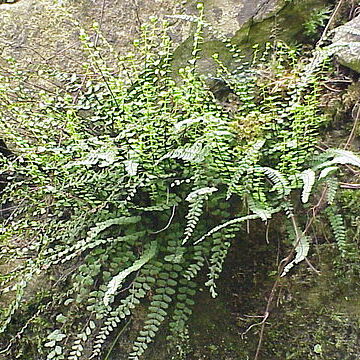Terrestrial, lithophytic or epiphytic ferns. Rhizome short-to long-creeping, with clathrate scales. Fronds monomorphic. Stipe usually glossy, castaneous to dark purplish or black, rarely grayish green. Lamina simple (not in Australia) or pinnate. Pinnae asymmetric, thin-textured, often with a portion towards the attachment and facing the rhizome (basiscopic) excised; basiscopic margin with main vein following close and parallel near its base, entire; margin facing the apex (acroscopic) crenate or serrate; veins free, rarely anastomosing (not in Australia), conspicuous, usually with 1–many branching acroscopically from main vein of pinna before the first vein branches basiscopically. Sori elongate along veins, away from lamina margins, protected by elongate indusia attached to the veins. Spores bilateral, ellipsoid to subglobose, winged, spiny (not in Australia) or papillose (not in Australia).
Terrestrial, lithophytic or epiphytic ferns. Rhizome erect or short-creeping, rarely long-creeping (not in Australia), with clathrate scales. Fronds monomorphic or rarely dimorphic, sometimes proliferous. Stipe dull or glossy, black, red-brown, brown or green, glabrous to densely hairy or scaly. Lamina simple or 1–5-pinnate, glabrous, hairy or scaly; margin entire to doubly serrate or lobed; pinnae symmetric or asymmetric, thin-textured to thick and fleshy; veins free or rarely anastomosing, inconspicuous or conspicuous. Sori elongate along veins, away from or close to and parallel to lamina margins, protected by elongate indusia attached along veins or indusium absent. Spores echinate (not in Australia), reticulate or costate-alate.
Petiole mostly wiry, green to black, sparsely scaly, otherwise glabrous, with 2 bundles below, these united above into a single bundle mostly X-shaped in section; lvs clustered, the blade simple and entire to thrice pinnate; veins free except in A. rhizophyllum; sori on the lower lf-surface, ± elongate, the indusia attached at one side, all facing distally, thin and hyaline, glabrous, entire; mostly ± evergreen ferns with short-creeping to suberect rhizomes and membranous to coriaceous lvs. 600+, mostly warm reg. (Camptosorus) Our spp. produce ± sterile hybrids and also enter into a large polyploid complex. The following names are believed to apply to sterile hybrids, as indicated:
Indusium well-developed; sporangia and sori as in family. Rhizome short, ascending; stipites clustered; paleae us. conspicuous, hairs us. present. Fronds pinnate to decompound, rarely simple; lamina us. firm to coriac.; veins free or with occ. anastomoses. A subcosmopolitan genus with over 650 spp.
Roots fibrous, not proliferous or proliferous and producing tiny plantlets. Stems erect, rarely long-creeping; scales basally attached, clathrate. Petioles not articulate. Blades 1--4-pinnate, of diverse size and shape. Indusia present. x = 36.
Sori all facing the same way except in a few species which have simple fronds and then the raised line between adjacent sori lacking

